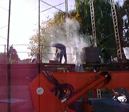How can silica dust be controlled?
Water spraying, vacuuming or other ventilation, or isolation can reduce the dust getting into the air. Respirators can protect the worker from breathing airborne dust.
Water is often the best option for dust control. It works best when a water spray is directed right at the point of cutting or grinding. A fine mist is generally more effective than a water stream. Wetting or dampening the surface alone before starting is usually not very effective because almost immediately cutting or grinding will get below the wet surface, generating dust. Generally speaking, the more water used, the better airborne dust control.

Table saws usually use water for silica dust control. This explains why exposures for table saws are lower than many other tools. Maintenance of the saw’s water reservoir is very important for good water flow and control.
We have done studies at the UW to test how well vacuums attached to tools control silica dust. For a tuck point grinder, surface grinder, and brick saw, dust was reduced by 80-90% when working on flat surfaces. Control will be somewhat less when working on columns or edges, when the tool moves past the edge. For good dust control, the vacuum needs to be powerful – rated at 90 cfm airflow or better. The vacuum bag needs to be changed often.
Isolating the dusty activity, by tenting off or otherwise separating the worker doing the dusty work from others on the site, is good for controlling silica exposure for nearby workers. It can, however, significantly increase the dust level for the worker inside the enclosure. A good way to reduce the dust inside the enclosure is to exhaust dust out of the enclosure using a fan with flexible ducting. A filter sock can be attached to the exhaust end of the duct to collect the dust.
